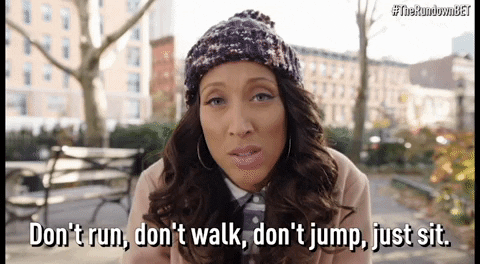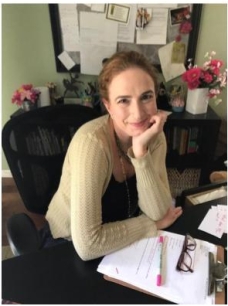Hello #ReVISIONweek revisers! Happy HUMP day! I hope you’ve had two wonderfully productive days of revision, and are excited for day 3!

Today’s post is perfect for a mid-week check-in. Joana Pastro is here to make sure you’ve tackled your revisions in a way that has stayed true to your vision. Joana’s delightful debut picture book, LILLYBELLE, A DAMSEL NEVER IN DISTRESS, illustrated by Jhon Ortiz, will be published by Kane Press in Fall/2020.
Throw down your hatchets for just a moment and read on…

By Joana Pastro
You’ve been working on a story. You’ve revised it a few times. Now you’ve reached that point where you have no idea what to do next, but you know there’s room for improvement. You need FRESH EYES.

Having trusted peers to guide you along the revision path is essential. So if you don’t have a critique group yet, get one!

Then send your beloved manuscript to your new critique partners.
Once you receive feedback, savor the praise. It might be that they love the premise, the voice was spot on, that they couldn’t stop laughing, or maybe that you pulled on their heartstrings. Hooray!

But—and there’s ALWAYS a but—if your new critique partners are doing their jobs, then they’ll also tell you how to improve your manuscript. Maybe they think the stakes aren’t high enough, or maybe there’s not enough heart, or maybe you have two problems. In the end, though, it will always be up to you to put their advice through your personal colander to decide what fits with your vision for the story.

Feedback can point out issues with:
- Line edits: grammar, punctuation, word choice.
- Showing versus telling
- Voice
- Heart
- Structure
- Point of View (POV)
- Premise
- Potential/Marketability
- Controversial issues
- And more!

So, how do you start revising? You will probably find that some suggestions resonated with you immediately. I find that to be especially true about line edits. You might be able to incorporate those right away.

But what about the rest? The suggestions or questions that:
a) resonate with you, but require some pondering.
b) you’re not sure what to do with, but might be worth giving a try.
c) make you want to “kill the messenger” err critiquer. (Don’t.)
Here’s what I do:
I print my manuscript, and write all the comments down using a different color per critiquer. This way I can refer back to the comments at any time without having to go through all the hard copies or files again. My copy will look something like this:

Now, take a step back.
Really.
Resist the urge to jump right back into revisions.

Let those questions and suggestions simmer, and allow your ideas to bloom. You’ll be surprised at how much work your brain does without you even realizing it.
Take a walk, a shower, a nap, work on something else.
Eat some chocolate!

Let your manuscript sit.
After a few days, come back and read again. Remember this: revisions are fueled by questions. Be ready to ask and answer lots of them.

At this point, you should be able to start revising with a much better grasp of what to keep from the feedback, and how to proceed.
- You might want to give some of the suggestions a try. For instance, write it in a different point of view, structure, or even switch your main character.
- You should be able to assess how much your story will change if you add that little detail, or change that scene. How much of my story will need to be reworked? Is it worth it?
- Ask questions. Would my character do this? Does this make sense? Is he behaving and/or sounding like say a four-year-old?
- Do I have more than one story problem and/or more than one goal? Sometimes a critique partner will pick one for you and make suggestions based on that. Is this the story I want to tell? What do you want the reader to take away?
- Does this align with my vision? Is this the story I want to tell? (Yes, you should be asking this question over and over again.)
- Sometimes someone suggests something that seems like total nonsense. BUT WAIT A SECOND… that idea that doesn’t work at all, or it might open a different, more interesting path for your story. Don’t discard the nonsense!
Now that you’ve asked and answered all of those burning questions, dive in!

Enjoy the ride, and happy revision!

———————————————————-

Originally from Brazil, Joana now lives in Florida with her amazing husband, her three extremely creative children and a rambunctious Morkie. For as long as Joana can remember, she wanted to be an artist of some kind. So, she became an architect. But once her first child was born, all the visits to the library, and the countless story times made Joana start dreaming of becoming a children’s book author. She had no idea how to start, so for seven years all she did was collect story ideas on a little notebook. Finally, one Sunday afternoon she decided to sit down and write…
Joana is a member of SCBWI and is represented by Natascha Morris with Bookends Literary. Her debut picture book, LILLYBELLE, A DAMSEL NEVER IN DISTRESS, illustrated by Jhon Ortiz, will be published by Kane Press in Fall/2020. Much like LillyBelle, Joana Pastro loves a good tea party . . . or any party, really! When not writing, you can find Joana baking (and eating) delicious desserts, singing as loud as she can, or twirling around the house. Visit her at www.joanapastro.com, and on twitter @jopastro.
Excellent advice, thanks!! So many gifs in one post make my eyes go a bit wibbly-wobbly and make it hard for me to concentrate on the text, but I’m probably just weird like that. The revision tips are really helpful!
You’re welcome! That’s a very good point about the gifs. I’ll pay more attention to that next time! Thanks!
What a great idea to write critique partners’ comments in different colours on a text. I always collate them in one document but have never done this before. Thanks for a great tip!
Hi Catherine, the color coding really helps me see the suggestions. One thing I didn’t mention is that when my CPs are in agreement, I underline the recurring comments with the color coding. The big rainbow markup is very persuasive! I know that area needs revising.
I agree that “letting it simmer” is easy to skip but so important to making a real difference following feedback!
Hi Tanya, it took me sometime to understand it wasn’t wasting time. Actually, on the contrary, after a few days of simmering, revisions flow a lot easier.
Thanks!
You have a great process, Joana, especially letting CP comments marinate for awhile and asking yourself if this revision is true to your vision. Thanks
Hi, Dee! Well, I do have the best CPs! Thanks for stopping by!
Thanks Joana. I definitely have a hard time finding focus after many wonderful critiques. I’m trying to get to the meat of my story! Great advice.
You’re welcome, Sarah! Good luck getting to the meat of your story!
Thank you, Joana, for the many helpful tips. I love the idea of using different colors for each critique partner on one MS. It does make me a bit crazy to have to go back to each hard copy.
You’re very welcome! I hope color coding helps make your revision process easier.
The color coded mark-up was a light bulb moment— especially highlighting the areas where several people have made similar comments. So helpful. Looking forward to trying it out later today.
Yay, Sarah! I love light bulb moments! Let me know how it goes!
Chocolate. Always chocolate. ❤️
Always! ❤️
Great post, Joana! CP feedback is so important to making our stories the best they can be. But, you’re absolutely right. You can’t take every piece of advice from every CP on every draft you write! These are great tips on how to sift through it all and stay true to the story YOU are telling. (Love the Men In Black, gif by the way. Will Smith cracks me up.)
I have the best CPs, you know? 🙂
So important! I’m lucky to have amazing CPs that happen to be my best friends! I love that gif too. 🙂
Thank you for sharing! I’ll have to try this 🙂 And congratulations on your upcoming release!
Thank you, Kiley! Happy revising!
Thanks, Kiley! Happy revising!
I LOVE my critique partners! They are very giving of their time, supportive, kind, but tell you what is sometimes hard to hear. I appreciate the honesty!
I love mine too! Honesty is what we need from our CPs to help take our work to the next level. Thanks for commenting!
Thank you, Joanna this advice is so helpful and I bought new highlighter pens today, so I can highlight all the issue’s that my critique group have brought up…any excuse to buy new stationery!
I love it, Stacey. I am too a big fan of stationery! I hope color coding will help your process too!
I love the idea of writing ALL the critique comments I receive from my group on one manuscript. What a fabulous way to clearly see the BIG problem spots everyone picked up on. Thank you!
Hi Leslie, you’re very welcome. I’m so glad you liked that idea. I hope it helps!
Happy revising!
Such good advice! I find that when I let a critique sit for a couple of days, I’m more open to the suggestions. And even the ones that didn’t resonate sometimes take me to the perfect place, just like you said. I have a couple of critiques I’ve been sitting on that I need to revisit. Thanks for the motivation!!
Thanks, Kailei! Yay for motivation! Happy revising!
Your list of questions to ask myself we’re very helpful. Thank you for sharing how you handle critique comments and suggestions!
Yay! I’m so happy the questions and tips resonated with you!
I hope they help take your manuscript to the next level!
So do I!
I sense a theme of letting our stories simmer. We can’t hear that enough! Thanks for all the other wonderful advice, Joana! Congrats on your book, too!
Thank you so much, Kim! Let it simmer and revise away!
I love the “personal colander” idea… that summarizes it perfectly. Thanks for these tips. I think I can be too eager to apply feedback, and so letting a ms sit is hard for me. But, as that seems to be a trend throughout all these posts, perhaps I should give it a go! 🙂
Hi Samantha, do give it a try! Work on a new story, relax, have some fun. Good luck and happy revising!
thank you for sharing! When do you take a step back from everyones “suggestions” because I am starting to lose sight of my initial concept? Or I’ve run into-no comments needed while I go over their ms. with a fine tooth comb and sometimes the back/forth is endless. I agree that I need more simmer time. Best get out and walk the dog again!
Hi Sharon! To me it’s a gut feeling. I’ll revisit my pitch, think about the heart of the ms, and what I want readers to takeaway from my story. I once wrote a lyrical friendship story that, after a few critiques, organically transitioned to a humorous how-to story that I absolutely love!
Thanks, Joana! This was perfect timing. I am working on a revision to take an old MS back to my original concept, and this is so helpful. Thank you!
You’re very welcome, Amy!
What great advise. I especially like the idea of writing all my critique partners comments in different colors on one copy of the MS. Usually I have a whole bunch of copies and am paging back and forth. Thank you!
You’re welcome, Eileen! Give it a try, I hope it makes your process a lot easier.
Great tips! Love the different colors for comments and letting the comments simmer. Something rejected today can make total sense tomorrow.
True! Happy revising, Kim!
Great post! Love your questions to ask myself. I use the colored pen method, too! I actually love doing that step. I often need weeks to let story issues simmer. Especially when my problem is 2 problems. Ha. Descisions. Congrats on your new book!
Thank you, Tracy! I love that step too. I think the color coded transcription engages other senses and makes the simmering even more effective.
Two problems is a big problem! Lol
Good luck!
Color coding the MS is such a great idea. Especially when you have multiple critique groups and comments are in separate documents. A good way to bring it all together to see if anything is overlapping, etc. Thanks for the tips.
Hi Ashley, I’m so happy you enjoyed this post. Happy revising to you!
Super helpful tips, Joana! As hard as it is, I always try to let the feedback simmer a few days before starting revisions. I’m so excited to meet Lillybelle- Congratulations, my friend!
Thank you so much, my dear! Best of luck to you!
Thanks, Joana. Good idea to put everyone’s feedback on one document.
You’re welcome, Jennifer. I hope it helped you during ReVISIONweek and beyond!
It is so important to let the feedback simmer for a bit before you react. I’ve had feedback that made me feel like my writing was complete trash, but after sleeping on it (or stepping away for longer) I can come back to the feedback, see clearly how I can make my writing better, and revise accordingly. It might not mean I take the CP’s suggestion, but I take seriously the fact that something wasn’t right to them, and try to improve.
You summed it up perfectly. Taking the fact that something isn’t right seriously, is the first step to improving our work. Best of luck to you!
I love the idea of highlighting in different colors for each critiquer! I’ll have to start doing this. Presently we all comment on a google doc and I print that off with all their suggestions and concerns. I’m going to add color coding next time around.
Hi Cheryl! It helps me a lot, I hope it works for you too! Good luck!
Letting it simmer is a struggle for me. I am such an eager beaver. But now that you mention chocolate…
Thank you. Great tips in this post.
Yes, chocolate does make everything better! Happy revising!
Love the idea to use different colors for each CP’s comments and having it all in one document. Genius!
Thanks, Hollie! I hope the color coding is already helping your process! Good luck!
I’ve done the color-coding within a Word doc, but I can see how printing it out and color-coding with handwritten notes can help you digest the comments. Good idea!
Hi there! Yes, I think handwriting it makes the brain work and process the ideas in a more efficient way. At least it works better for me. Hope it helps you too!
Great advice! Such a hard balance between keeping your vision for the story and being open to feedback. I love my critique partners. Waiting a day or two can definitely help when you’re unsure whether you’re resistant to an idea because you need to kill your darlings or because it just doesn’t fit your vision.
Hi, Rachel! I love my critique partners. I know they want the best for my story and that’s how it should be. So glad you found great CPs too. Happy revising!
I like your list of issues to look at in a manuscript, Joana. They not only offer a great way to critique your own manuscript but also a way to critique your CP manuscripts. I also like your idea to write all the comments down using a different color per critiquer. Great post, Joana! Thank you for sharing.
Thank you so much, Cathy! I hope the list and color coding has already help take your manuscript to a different level!
Thanks so much, Joana. The different colored pens is great. Love all your ideas especially letting the feedback percolate (why is that so hard for me?) and eating chocolate (not so hard for me). Can’t wait to see Lillybelle in book form. I remember when you first read her.
Hello, my dear! I’m so glad you enjoyed this post! I can’t wait to see your next one! Happy revising!
Congratulations on your upcoming PB! And I send my sincerest THANKS for the color coding idea. I am going to implement that strategy immediately. Finding critique groups has been the best possible thing for me. I just started this summer with a couple groups and have seen my writing improve more in the past few months than it had in the past few years. Thanks again for the great post!
Hi, Laurie! You’re very welcome. I’m so happy the post resonated with you. My experience BCG and ACG (before and after critique groups :)) is just like yours. I spent years writing without noticeable progress. I didn’t realize it until I joined a critique group and began seeing improvement. Happy revising!
You have given me a lot of great points to consider as I revise – thank you!
That’s awesome, Charlotte! Happy revising!
Thank you for all your great advice Joana! I definitely dive WAY to quickly back into revising after receiving feedback. I end up having multiple versions for my critique group so your advice to focus on your vision really resonates with me. Also, like the idea of writing out all the comments on one MS so you can see everything at the same time. Thanks!!
Hi, Jocelyn! I hope those strategies are already working for you. Best of luck!
This is great advice, Joana. And so well organized! 🙂
Thanks!
Hi, JD! Yay! I hope your revisions are going well! Good luck!
Yes, I’ve found I’m much more receptive to big-change suggestions if I let some time pass before considering them. I’m immediately happy to get line edits, though, because those feel like fast progress. Thanks for your tips.
You’re very welcome, Janet! I agree about line edits. It gives immediate satisfaction for sure! Best of luck!
Thanks, Joana. Timely post for me – I just had an agent say one section of my ms did not focus heavily enough on the grief aspect of my story. A week ago a professional critique said I laid it on too heavily at the grief section…Time to simmer! 🙂
I’m going to try writing out comments in different colours. Finding it hard to juggle 4-5 CP crits on separate documents.
Yes, Kirsten, I think we’ve all gone a bit insane with those conflicting opinions. Actually I’m going through a tough one right now. Guess what? I just read that feedback again and am letting it simmer once more. I hope the different colors help you too! Good luck!
This is great advice. I love the idea of marking up my document with all the feedback. I have been pretty good at noticing when I get the same feedback from multiple people, but it helps to mark those locations so you don’t get too tied to it and then won’t want to make changes.
My CP’s and I were just talking about the things that have been niggling at our brains, but we didn’t want to face it until someone else said the same thing. Even when we trust our gut, it can be hard to take advice from our inner voice. It’s wonderful to have critique partners who can share the same advice so we can’t ignore it. Maybe that advice needs it’s own special color to remind us to trust our gut.
I was wondering are Morkies from Orkie?
https://morkandmindy.fandom.com/wiki/Mork
Hi Sarah! Oh my! Yes, I have to admit that from time to time, I do send manuscripts off to critique with a known flaw just to see if anyone notices, and (to my despair) THEY ALWAYS DO!!!!! Ha! My CPs are too good! LOL.
I didn’t grow up in the US, so I had no clue what Mork And Mindy was, so now I must check it out. I can tell you right now, if an Orkan is cute, but extremely loud, than Morkies must be Orkies!
I love your idea of writing the comments and suggestions from your critique group on one manuscript. That makes it so much easier to process so you can decide which suggestions are best for your story. Thank you for these helpful ideas and congratulations on your new picture book, Joana!
Thanks, Pamela! I hope those ideas are already helping your story shine! Happy revising!
Thank you for your great advice. Congratulations on your new picture book!
Thanks, Karen! Happy revising!
Thanks for this thoughtful post, Joana! I look forward to reading your new book.
Awww Thank you! Happy revising to you!
Great tips! Thank you for sharing your process!
Thank you for stopping by, Mia! Happy revising!
I am in two critique groups and both are like GOLD!–both glittery and hard! In a good way. Like the idea of compiling all the comments on one printout, I haven’t tried that before. Thanks, Joana!
You’re welcome, Marianne! Cheers for golden critique partners! Mine are precious too! I hope the one printout is already proving to be helpful!
Great advice Joana! Color coding cp’s feedback is a great idea. So helpful!
Hi, Sherry! I hope it’s already working for you! Happy revising!
Great advice. I always let feedback simmer. Sometimes it’s a day, sometimes it’s a week, and sometimes it’s months. I’ve been working on a few MS in rotation and just when I think, “Okay, this is the one. It’s so close to done, I’ll focus on this one, I get fresh eyes or totally new feedback and it’s back to the drawing board.
I try to put all the feedback into one MS document, but I’ve never done it in color. 😊
Hi, Laura! I’ve been there. The timeframe varies from story to story. I had a parallel structured one that took me about nine months of intense labor to get right. I sent it to my agent along with another one and was amazed when she thought that was the strongest of the too. It was an excruciating, but totally worth it.
Hope the colors help! Good luck!
Great tips! You are so right about your brain thinking of your story when you don’t realize it.Thank you!
You’re welcome, Lori. I’m so happy this post resonated with you! Best of luck!
I find it challenging to figure out what questions to be asking. Your list is quite helpful. Thanks!
You’re welcome! Yay! So glad it’s helpful! Happy revising to you!
Thank you Joana I have a similar revision format and I agree line edits are the easiest and the first ones I do. Story changes are much harder but really add to the story.
You’re very welcome, Sharon. Story changes are challenging, and, most of the time, very rewarding! Good luck!